Europe, British Isles, South-West England, Wiltshire, Stonehenge Landscape, Stonehenge Monuments and Burials, Stonehenge
Stonehenge is in Stonehenge Monuments and Burials, Stonehenge Chronologically.
It is a curious fact that Five Wells Chambered Tomb [Map] is, within 0.2 of a degree of longitude, north of Stonehenge [Map] - see Five Wells Chambered Tomb and Stonehenge Alignment. Moreover, this line of longitude, give or take 500m, has the highest number of Neolithic and Early Bronze Age Monuments on it when compared to other lines of longitude. North to South:
Five Wells Chambered Tomb [Map]
Monkton Fields Long Barrow [Map]
Netheravon 6 Long Barrow [Map]
Normanton Barrow 151 G13 [Map]
Stonehenge.
Europe, British Isles, South-West England, Wiltshire, Stonehenge Landscape, Stonehenge Monuments and Burials, Prehistoric Stonehenge
Europe, British Isles, South-West England, Wiltshire, Stonehenge Landscape, Stonehenge Monuments and Burials, Prehistoric Stonehenge, Mesolithic Stonehenge
Blick Mead is a chalkland spring in Wiltshire, near to the River Avon. Excavation since 2005 indicates that there was continuous human habitation from 8000BC to 6000BC. 35,000 worked flints and 2400 animal bones, some cooked, mostly from Bos Longifrons, have been found at the site.
In 2017 a tooth from a domesticated dog was found. The tooth was from around 5000BC, and originally from Yorkshire.
Carbon Date. 7130BC. Mesolithic Carbon Dates
Report: charcoal; from hole A (depth 0.76m), half way between the top (natural chalk) and the base, at the edge of the hole.
ID: 17859, C14 ID: HAR 455 Date BP: 9130 +/- 180, Start Date BP: 9310, End BP: 8950
Abstract: Stonehenge, 20th Century: Car Park 1966; 1973-74
Reference Name: Jordan, D, Haddon-Reece, D, Bayliss, A 1994 'Radiocarbon dates: from samples funded by English Heritage and dated before 1981', London: English Heritage
Council for British Archaeology (2012) Archaeological Site Index to Radiocarbon Dates from Great Britain and Ireland [data-set]. York: Archaeology Data Service [distributor] https://doi.org/10.5284/1017767
Around 7000BC the Stonehenge Car Park Post Holes were created in what became the car park for the visitor's centre.
Carbon Date. 6880BC. Mesolithic Carbon Dates
Report: charcoal; from the base of the secondary fill of postpit 9580, at c 0.7m depth (context 9582). The pit was cut into the chalk, with chalk rubble fill.
ID: 17861, C14 ID: GU 5109 Date BP: 8880 +/- 120, Start Date BP: 9000, End BP: 8760
Abstract: Stonehenge, 20th Century: Car Park 1988; 1990-91
Reference Name: Bayliss et al forthcoming 'Radiocarbon dates: from samples funded by English Heritage between 1988 and 1993', Swindon: English Heritage
Council for British Archaeology (2012) Archaeological Site Index to Radiocarbon Dates from Great Britain and Ireland [data-set]. York: Archaeology Data Service [distributor] https://doi.org/10.5284/1017767
Carbon Date. 6880BC. Mesolithic Carbon Dates
Report: Charcoal, id as Pinus, from postpit WA 9580 at Stonehenge, Wiltshire, England. Comment (subm): see ref.
ID: 8028, C14 ID: GU-5109 Date BP: 8880 +/- 120, Start Date BP: 8760, End BP: 9000
OS Letter: SU, OS East: 123, OS North: 422
Archaeologist Name: F Vatcher & L Vatcher
Reference Name: Cleal, R M J et al, 'Stonehenge in its landscape: 20th century excavations' (Engl Heritage Archaeol Rep, 10, 1995), 47, 511; Archaeometry, 38, 1996, 401-7
Council for British Archaeology (2012) Archaeological Site Index to Radiocarbon Dates from Great Britain and Ireland [data-set]. York: Archaeology Data Service [distributor] https://doi.org/10.5284/1017767
Carbon Date. 6400BC. Mesolithic Carbon Dates
Report: charcoal:Pinus sp
ID: 6096, C14 ID: OxA-4920 Date BP: 8400 +/- 100, Start Date BP: 8300, End BP: 8500
Abstract: Stonehenge, England
Archaeologist Name: Allen
Reference Name: Archaeometry 38(2), 1996, 391-415
Council for British Archaeology (2012) Archaeological Site Index to Radiocarbon Dates from Great Britain and Ireland [data-set]. York: Archaeology Data Service [distributor] https://doi.org/10.5284/1017767
Carbon Date. 6090BC. Mesolithic Carbon Dates
Report: charcoal; from hole B, depth 0.91m from the surface of the natural chalk.
Abstract: Stonehenge, 20th Century: Car Park 1966; 1973-74
ID: 17860, C14 ID: HAR 456 Date BP: 8090 +/- 140, Start Date BP: 8230, End BP: 7950
Reference Name: Jordan, D, Haddon-Reece, D, Bayliss, A 1994 'Radiocarbon dates: from samples funded by English Heritage and dated before 1981', London: English Heritage
Council for British Archaeology (2012) Archaeological Site Index to Radiocarbon Dates from Great Britain and Ireland [data-set]. York: Archaeology Data Service [distributor] https://doi.org/10.5284/1017767
Europe, British Isles, South-West England, Wiltshire, Stonehenge Landscape, Stonehenge Monuments and Burials, Prehistoric Stonehenge, Stonehenge Phase I ![]()
Europe, British Isles, South-West England, Wiltshire, Stonehenge Landscape, Stonehenge Monuments and Burials, Prehistoric Stonehenge, Stonehenge Phase I, Stonehenge Phase 1 Aubrey Holes
Stonehenge Phase 1 Aubrey Holes is also in Stonehenge Neolithic.
Carbon Date. 3350BC. Middle Neolithic Carbon Dates
ID: 6090, C14 ID: OxA-4902 Date BP: 5350 +/- 80, Start Date BP: 5270, End BP: 5430
Abstract: Stonehenge, England
Archaeologist Name: Allen
Reference Name: Archaeometry 38(2), 1996, 391-415
Council for British Archaeology (2012) Archaeological Site Index to Radiocarbon Dates from Great Britain and Ireland [data-set]. York: Archaeology Data Service [distributor] https://doi.org/10.5284/1017767
Between 3000BC and 1500BC. Stonehenge Phase 1 Aubrey Holes are fifty-six pits 1m in diameter known as the Aubrey Holes after John Aubrey who first identified them. It isn't known whether the pits held posts or stones or neither.
The date for these holes, and consequently where they fit into the order of the wide monument is very vague. Excavation indicates Sarsen stone chips are found only in the upper layers suggesting the Aubrey holes pre-date the Sarsens.
The pits originally contained the 50,000 cremated bone fragments of sixty-three individuals which were excavated in 1920 by William Hawley who re-interred them in a single pit; Aubrey Hole 7.
In 2013 a team led by Mike Parker Pearson analysed the remains finding the individuals were equally male and female, including children, originally from south-west wales, the source of the Stonehenge Bluestones, and had not lived in the Stonehenge area for long before death. Evidence of chalk crushing at the base of the pits is believed to indicate the pits once contained the Stonehenge Bluestones as grave markers.
Carbon Date. 1798BC. Middle Bronze Age Carbon Dates
Report: Charcoal from Aubrey Hole 32 at Stonehenge, Wiltshire, England.
ID: 4514, C14 ID: C-602 Date BP: 3798 +/- 275, Start Date BP: 3523, End BP: 4073
OS Letter: SU, OS East: 123, OS North: 422
Archaeologist Name: S Piggott et al
Reference Name: Radiocarbon, 2, 1960, 27; Radiocarbon, 10, 1968, 288; Science, 114, 1951, 292; Antiquity, 41, 1967, 63-4; Antiquity, 50, 1976, 239-40; R Cleal et al, 'Stonehenge in its landscape' (1995) (re-phasing)
Council for British Archaeology (2012) Archaeological Site Index to Radiocarbon Dates from Great Britain and Ireland [data-set]. York: Archaeology Data Service [distributor] https://doi.org/10.5284/1017767
Europe, British Isles, South-West England, Wiltshire, Stonehenge Landscape, Stonehenge Monuments and Burials, Prehistoric Stonehenge, Stonehenge Phase I Bank and Ditches
The Stonehenge Phase I Bank and Ditches are believed to have been constructed around 3100BC although this would appear somehat inconsistent with the carbon dates which range from 2500BC to 2000BC? The source of the earlier date of 3100BC is unclear?
Europe, British Isles, South-West England, Wiltshire, Stonehenge Landscape, Stonehenge Monuments and Burials, Prehistoric Stonehenge, Stonehenge Phase 2 Timber Structure [Map]![]()
Stonehenge Phase 2 Timber Structure is also in Stonehenge Neolithic.
Between 2800BC and 2600BC. Stonehenge Phase 2 Timber Structure [Map] is irregular postholes dating to around 2800BC in the enclosure, at the north-east entrance and parallel post-holes inward from the south entrance. The 0.4m diameter postholes are smaller than the 1m Aubrey Holes. The bank was reduced, the ditch silted up. At least twenty-five Aubrey Holes were re-used for cremation burials. Thirty further cremations were placed in the enclosure's ditch and at other points within the monument, mostly in the eastern half. Dating evidence is through the presence of Grooved Ware.
Europe, British Isles, South-West England, Wiltshire, Stonehenge Landscape, Stonehenge Monuments and Burials, Prehistoric Stonehenge, Stonehenge Phase 3 I ![]()
Stonehenge Phase 3 I is also in Stonehenge Bronze Age.
Europe, British Isles, South-West England, Wiltshire, Stonehenge Landscape, Stonehenge Monuments and Burials, Prehistoric Stonehenge, Stonehenge Phase 3 I, Bluestone Circles aka Q and R Holes
Bluestone Circles aka Q and R Holes are believed to have been erected around 2600BC. Two concentric crescents of holes known as the Q and R holes - they could be concentric circles. The holes are believed to have contained the Bluestones which came from the Presceli Hills in South-West Wales.
Carbon Date. 1570BC. Middle Bronze Age Carbon Dates
Report: Antler from base of unfinished R hole (abandonment of double bluestone circle) at Stonehenge, Wiltshire, England.
ID: 4517, C14 ID: I-2384 Date BP: 3570 +/- 110, Start Date BP: 3460, End BP: 3680
OS Letter: SU, OS East: 123, OS North: 422
Archaeologist Name: S Piggott et al
Reference Name: Radiocarbon, 2, 1960, 27; Radiocarbon, 10, 1968, 288; Science, 114, 1951, 292; Antiquity, 41, 1967, 63-4; Antiquity, 50, 1976, 239-40; R M Cleal et al, 'Stonehenge in its landscape' (1985) (rephasing)
Council for British Archaeology (2012) Archaeological Site Index to Radiocarbon Dates from Great Britain and Ireland [data-set]. York: Archaeology Data Service [distributor] https://doi.org/10.5284/1017767
Europe, British Isles, South-West England, Wiltshire, Stonehenge Landscape, Stonehenge Monuments and Burials, Prehistoric Stonehenge, Stonehenge Phase 3 I, Slaughter Stone [Map]
Slaughter Stone [Map] and one, or possibly two, large portal stones were erected just inside the north-eastern entrance during Stonehenge Phase 3 I. Only the fallen Slaughter Stone 4.9m long, now remains. The date of the erection of the stone is unknown.
Europe, British Isles, South-West England, Wiltshire, Stonehenge Landscape, Stonehenge Monuments and Burials, Prehistoric Stonehenge, Stonehenge Phase 3 II Sarsens ![]()
Stonehenge Phase 3 II Sarsens is also in Stonehenge Late Neolithic Early Bronze Age.
Stonehenge Phase 3 II Sarsens describes the erection of a number of standing stones: Heel Stone [Map], Slaughter Stone [Map] and the Station Stones.
Carbon Date. 2520BC. Late Neolithic Carbon Dates
Report: Bone: Bos primigenius
ID: 6074, C14 ID: OxA-4842 Date BP: 4520 +/- 100, Start Date BP: 4420, End BP: 4620
Abstract: Stonehenge, England
Archaeologist Name: Allen
Reference Name: Archaeometry 38(2), 1996, 391-415
Council for British Archaeology (2012) Archaeological Site Index to Radiocarbon Dates from Great Britain and Ireland [data-set]. York: Archaeology Data Service [distributor] https://doi.org/10.5284/1017767
Europe, British Isles, South-West England, Wiltshire, Stonehenge Landscape, Stonehenge Monuments and Burials, Prehistoric Stonehenge, Stonehenge Phase 3 II Sarsens, Heel Stone [Map]
Heel Stone [Map] is a sarsen stone. It was accompanied by a second stone which is no longer extant. The date of the erection of the stone is unknown.
Europe, British Isles, South-West England, Wiltshire, Stonehenge Landscape, Stonehenge Monuments and Burials, Prehistoric Stonehenge, Stonehenge Phase 3 II Sarsens, Station Stones
Station Stones. Four sarsen stones, two of which stood on top of mounds. The erection of the stones post-date the construction of the ditch.
Stonehenge Phase 3 II Sarsens describes the erection of a number of standing stones: Heel Stone [Map], Slaughter Stone [Map] and the Station Stones.
Europe, British Isles, South-West England, Wiltshire, Stonehenge Landscape, Stonehenge Monuments and Burials, Prehistoric Stonehenge, Stonehenge Phase 3 II Sarsens, Stonehenge Phase 3 II Sarsen Circle [Map]
2500BC. Stonehenge Phase 3 II Sarsen Circle [Map] is the erection in 2500BC ±100 years of thirty sarsen stones with lintels forming a 33m Stone Circle. Thirty may be significant given the number of days in a month in early calendars. The stones came from West Woods Quarry 25km away. The stones were dressed. The lintels secured using tongue and groove joints. Each standing stone was 41.m high, 2.1m wide and weighed around 25,400kg. The lintel stones are 3.2m long, 1m wide, 0.8m thick and slighted curved.
Carbon Date. 2023BC. Early Bronze Age Carbon Dates
Report: Antler, from context 1093, Sarsen Circle Stonehole 1 [Map] (C2.1), Phase 3ii at Stonehenge, Wiltshire, England. Comment (subm): Date accepted as reliable; 2 sigma cal range given.
ID: 8063, C14 ID: UB-3821 Date BP: 4023 +/- 21, Start Date BP: 4002, End BP: 4044
OS Letter: SU, OS East: 123, OS North: 422
Archaeologist Name: (ed Cleal)
Reference Name: Cleal, R M J et al, 'Stonehenge in its landscape: 20th century excavations' (Engl Heritage Archaeol Rep, 10, 1995), 204, ??? 2, Table 64; Archaeometry, 38, 1996, 401-7
Council for British Archaeology (2012) Archaeological Site Index to Radiocarbon Dates from Great Britain and Ireland [data-set]. York: Archaeology Data Service [distributor] https://doi.org/10.5284/1017767
Europe, British Isles, South-West England, Wiltshire, Stonehenge Landscape, Stonehenge Monuments and Burials, Prehistoric Stonehenge, Stonehenge Phase 3 II Sarsens, Stonehenge Phase 3 II Sarsen Horseshoe [Map]
Stonehenge Phase 3 II Sarsen Horseshoe is also in Stonehenge Late Neolithic Early Bronze Age.
2500BC. Stonehenge Phase 3 II Sarsen Horseshoe [Map] is five dressed sarsen trilithons arranged in horseshoe shape 13.7 metres across with its open end facing the midsummer sunrise. The largest trilithon is the middle one of which only one stone remains: 6.7m remains above ground but would have been 7.5m when complete, 2.4m below ground, around 50,000kg. The next two are smaller, around 6.7m and the last two smaller still; 6m high.
Europe, British Isles, South-West England, Wiltshire, Stonehenge Landscape, Stonehenge Monuments and Burials, Prehistoric Stonehenge, Stonehenge Phase 3 III Bluestones Circle I
2340BC. Stonehenge Phase 3 III Bluestones Circle I. Around 2340BC ±60 years the Bluestones were re-erected in a circle between the Stonehenge Phase 3 II Sarsen Circle [Map] and the Stonehenge Phase 3 II Sarsen Horseshoe [Map]. Some appear to have been carved to support lintels.
Europe, British Isles, South-West England, Wiltshire, Stonehenge Landscape, Stonehenge Monuments and Burials, Prehistoric Stonehenge, Stonehenge Phase 3 IV Bluestones Circle II
Stonehenge Phase 3 IV Bluestones Circle II. Around 2100BC ±180 years the Bluestones were re-arranged again to form a circle between the Stonehenge Phase 3 II Sarsen Circle [Map] and the Stonehenge Phase 3 II Sarsen Horseshoe [Map], and an oval inside the Stonehenge Phase 3 II Sarsen Horseshoe [Map].
Europe, British Isles, South-West England, Wiltshire, Stonehenge Landscape, Stonehenge Monuments and Burials, Prehistoric Stonehenge, Stonehenge Phase 3 V Bluestone Horseshoe [Map]
Stonehenge Phase 3 V Bluestone Horseshoe [Map]. Around 1900BC the Bluestones were moved to form horseshoe shape mirroring the central three trilithons.
Europe, British Isles, South-West England, Wiltshire, Stonehenge Landscape, Stonehenge Monuments and Burials, Prehistoric Stonehenge, Stonehenge Phase 3 VI X and Y Holes
The Stonehenge Y and Z Holes are two rings of concentric (though irregular) circuits of 30 and 29 near-identical pits cut around the outside of the Sarsen Circle at Stonehenge. These holesare considred the last known structural activity at Stonehenge.
Carbon Date. 1449BC. Late Bronze Age Carbon Dates
Report: Antler, from context 3927, Y Hole 30, stacked on base (C34.30), Phase 3vi at Stonehenge, Wiltshire, England. Comment (subm): Date accepted as reliable; 2 sigma cal range given.
ID: 8072, C14 ID: UB-3824 Date BP: 3449 +/- 24, Start Date BP: 3425, End BP: 3473
OS Letter: SU, OS East: 123, OS North: 422
Archaeologist Name: (ed Cleal)
Reference Name: Cleal, R M J et al, 'Stonehenge in its landscape: 20th century excavations' (Engl Heritage Archaeol Rep, 10, 1995), 260, ??? 2, Table 64
Council for British Archaeology (2012) Archaeological Site Index to Radiocarbon Dates from Great Britain and Ireland [data-set]. York: Archaeology Data Service [distributor] https://doi.org/10.5284/1017767
Carbon Date. 1341BC. Late Bronze Age Carbon Dates
Report: Antler, from context 3927, Y Hole 30, stacked on base (C34.30), Phase 3vi at Stonehenge, Wiltshire, England. Comment (subm): Date accepted as reliable; 2 sigma cal range given.
ID: 8070, C14 ID: UB-3822 Date BP: 3341 +/- 22, Start Date BP: 3319, End BP: 3363
OS Letter: SU, OS East: 123, OS North: 422
Archaeologist Name: (ed Cleal)
Reference Name: Cleal, R M J et al, 'Stonehenge in its landscape: 20th century excavations' (Engl Heritage Archaeol Rep, 10, 1995), 260, appendix 2, Table 64
Council for British Archaeology (2012) Archaeological Site Index to Radiocarbon Dates from Great Britain and Ireland [data-set]. York: Archaeology Data Service [distributor] https://doi.org/10.5284/1017767
Carbon Date. 1300BC. Late Bronze Age Carbon Dates
Report: Antler, from context 3927, Y Hole 30, stacked on base (C34.30), Phase 3vi at Stonehenge, Wiltshire, England. Comment (subm): Date accepted as reliable; 2 sigma cal range given.
ID: 8071, C14 ID: UB-3823 Date BP: 3300 +/- 19, Start Date BP: 3281, End BP: 3319
OS Letter: SU, OS East: 123, OS North: 422
Archaeologist Name: (ed Cleal)
Reference Name: Cleal, R M J et al, 'Stonehenge in its landscape: 20th century excavations' (Engl Heritage Archaeol Rep, 10, 1995), 260, ??? 2, Table 64
Council for British Archaeology (2012) Archaeological Site Index to Radiocarbon Dates from Great Britain and Ireland [data-set]. York: Archaeology Data Service [distributor] https://doi.org/10.5284/1017767
Carbon Date. 1190BC. Late Bronze Age Carbon Dates
Report: Antler (1923) from base of Y hole 30 (Phase IIIb/IIIc transition) at Stonehenge, Wiltshire, England.
ID: 4611, C14 ID: I-2445 Date BP: 3190 +/- 105, Start Date BP: 3085, End BP: 3295
OS Letter: SU, OS East: 123, OS North: 422
Archaeologist Name: S Piggott et al
Reference Name: Radiocarbon, 2, 1960, 27; Radiocarbon, 10, 1968, 288; Science, 114, 1951, 292; Antiquity, 41, 1967, 63-4; Antiquity, 50, 1976, 239-40; R M Cleal et al, 'Stonehenge in its landscape' (1985) (rephasing)
Council for British Archaeology (2012) Archaeological Site Index to Radiocarbon Dates from Great Britain and Ireland [data-set]. York: Archaeology Data Service [distributor] https://doi.org/10.5284/1017767
Europe, British Isles, South-West England, Wiltshire, Stonehenge Landscape, Stonehenge Monuments and Burials, Historic Stonehenge
Grafton's Chronicle. 543. When Constantine had thus subdued his enimies and thought himself now in a sure and quiet state: then arose up his own kinsman named Aurelius Conamis and arrered mortal battle against him, and at the last slew him in the Field, when he had reigned three yeres, who was buried at Stonehenge. But some writers say, he died by the hand of God of a great sickness.
Histories of the Kings of Britain: Book VIII. Accordingly he called together from all quarters the master craftsmen in stone and wood, and bade them put forth their utmost skill to contrive some new kind of building that should stand for ever in memory of men so worthy. But all of them, mistrusting their own mastery in such a matter, were only able to meet him with a 'Nay.' Whereupon Tremounos, Archbishop of Caerleon, came unto the King and saith he: 'If man there be anywhere strong enow to carry out this ordinance into effect, let Merlin, Vortigern's prophet, set hand thereunto. For well I wot that never another man in thy kingdom is there that is brighter of wit than he, whether it be in foretelling that which shall be or in devising engines of artifice. Bid him come hither and set his wits to work, and I warrant he shall build thee a memorial to last!' Accordingly, when Aurelius had asked many questions about him, he sent divers messengers through the divers countries of the kingdom to find and fetch him; and after they had journeyed throughout the provinces they found him in the country of the Gewissi, at the fountain of Galabes that he wont to haunt, and, telling him what it was they wanted, brought him unto the King. The King received him gladly and bade him declare the future, being fain to hear marvellous things. Unto whom Merlin: 'Mysteries of such kind be in no wise to be revealed save only in sore need. For, and I were to utter them lightly or to make laughter, the spirit that teacheth me would be dumb and would forsake me in the hour of need.' At last, when he had in like manner denied them all, the King was not minded to ask him further about the future, but spake unto him of the work he did propose to construct. Unto whom Merlin:
'If thou be fain to grace the burial-place of these men with a work that shall endure for ever, send for the Dance of the Giants that is in Killaraus, a mountain in Ireland. For a structure of stones is there that none of this age could raise save his wit were strong enough to carry his art. For the stones be big, nor is there stone anywhere of more virtue, and, so they be set up round this plot in a circle, even as they be now there set up, here shall they stand for ever.'
The Chronicle of Henry of Huntingdon Book 1. There are four things in England which are yery remarkable. One is that the winds issue with such great violence from certain caverns in a mountain called the Peak [Probably the Devil's Arse [Map]] that It ejects matters thrown into them, and whirling them about in the air carries them to a great distance. The second is at Stonehenge, where stones of extraordinary dimensions are raised as columns, and others are fixed above, like lintels of immense portals; and no one has been able to discover by what mechanism such vast masses of stone were elevated, nor for what purpose they were designed. The third is at Chedder-hole1, where there is a cavern which many persons have entered, and have traversed a great distance under ground, crossing subterraneous streams, without finding any end of the cavern. The fourth wonder is this, that in some parts of the countiy the rain is seen to gather about the tops of the hills, and forthwith to fall on the plains.
Note 1. Wookey Hole, in Cheddar Cliffs, under the Mendip Hills, in Somersetshire.
Around 1574. This is one of the oldest depictions of Stonehenge in existence, and the first to have been drawn on site. The image was produced by Lucas de Heere, a Flemish Protestant exile living in England between 1567 and 1576. The watercolour illustrates a page from De Heere's guidebook to Britain, entitled Corte Beschryvinghe van England, Scotland, ende Irland. His depiction is important because of its accuracy and the insights it provides into prehistoric construction techniques. Tenons, the projectile part of a mortise and tenon joint, are shown on top of two of the standing stones in the foreground. These stone projections locked into corresponding holes known as mortises carved into the base of a lintel. Mortise and tenon joints are thousands of years old, and were used to erect Stonehenge between 2600 and 2400 CE.
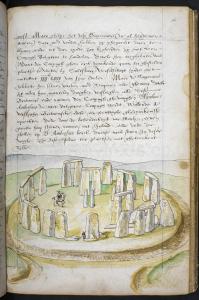
1610. John Speed's Map of 1610 with Stonehenge in the top right corner.
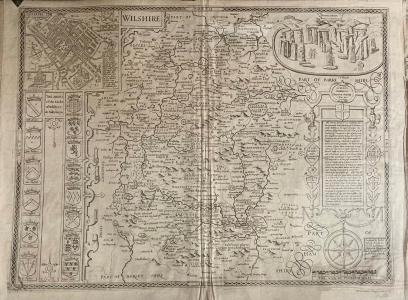
Evelyn's Diary. 22 Jul 1654. Now we arrived at Stonehenge, indeed a stupendous. Monument, appearing at a distance like a castle; how so many and huge Pillars of stone should have been brought together, some erect, others transverse on the tops of them, in a circular area as rudely representing a cloister or heathen and more natural temple, is wonderful. The stone is so exceedingly hard, that all my strength with a hammer could not break a fragment; which hardness I impute to their so long exposure. To number them exactly is very difficult, they lie in such variety of postures and confusion, though they seemed not to exceed 100; we counted only 95. As to their being brought thither, there being no navigable river near, is by some admired; but for the stone, there seems to be the same kind about 20 miles distant, some of which appear above ground. About the same hills, are divers mounts raised, conceived to be ancient intrenchments, or places of burial, after bloody fights. We now went by Devizes, a reasonable large town, and came late to Cadenham.
Pepy's Diary. 09 Jun 1668. Tuesday. When come to Oxford, a very sweet place: paid our guide, £1 2s. 6d.; barber, 2s. 6d.; book, Stonage [Stonehenge], 4s1.
Note 1. This must have been either Inigo Jones's "The most notable Antiquity of Great Britain vulgarly called Stonehenge", printed in 1655, or "Chorea Gigantum, or the most famous Antiquity of Great Britain, vulgarly called Stones Heng, standing on Salisbury Plain, restor'd to the Danes", by Walter Charleton, M.D., and published in 1663.
Pepy's Diary. 11 Jun 1668. Thence to the inne; and there not being able to hire coach-horses, and not willing to use our own, we got saddle-horses, very dear. Boy that went to look for them, 6d. So the three women behind W. Hewer (age 26), Murford, and our guide, and I single to Stonage; over the Plain and some great hills, even to fright us. Come thither, and find them as prodigious as any tales I ever heard of them, and worth going this journey to see. God knows what their use was! they are hard to tell, but yet maybe told. Give the shepherd-woman, for leading our horses, 4d. So back by Wilton [Map], my Lord Pembroke's (age 47) house, which we could not see, he being just coming to town; but the situation I do not like, nor the house promise much, it being in a low but rich valley. So back home; and there being 'light, we to the Church, and there find them at prayers again, so could not see the Quire; but I sent the women home, and I did go in, and saw very many fine tombs, and among the rest some very ancient, of the Montagus1.
Note 1. The Montacutes, from whom Lord Sandwich's (age 42) family claimed descent: B.
1670 to 1690. Stonehenge [Map] is shown from the south and west in these King's Topographical Collection prospects by David Loggan. Locals, tourists and gentlemen antiquaries can be seen visiting the prehistoric monument. Loggan's plate was first published in the mid-1680s and later re-issued in the fourth volume of the 1724 edition of Britannia Illustrata.
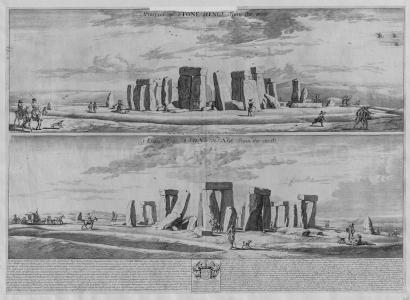
Stonehenge by William Stukeley. Stonehenge A Temple Restored To The British Druids By William Stukeley (age 52). Rector Of All Saints In Stamford. To His Grace Peregrine Duke Of Ancaster And Kesteven (age 25), Hereditary Lord Great Chamberlain Of England, &C. &C. London: Printed For W. Innys And R. Manby, At The West End Of St. Paul's. MDCCXL.
1798. Letter of William Cunnington (age 44)
I have also visited Stonehenge since I saw you, where, in digging with a large stick under those two very large stones1 which fell down about three years ago, I was much surprised to find several pieces of black pottery similar to those found on the above downs, among which was the bottom of a small vessel in form like the bottom of a tumbler glass, but of the same black fine polished pottery above, which I used to think was Roman. I also found several bones of deer or sheep. From these specimens of pottery, the magnitude of this stupendous structure, and other circumstances, I am of opinion our ancestors (if I may so call them) were not so barbarous nor so ignorant of the arts as some suppose them when the Romans first invaded this isle.
Note 1. The stones of the northern trilithon which fell on 3 January 1797.
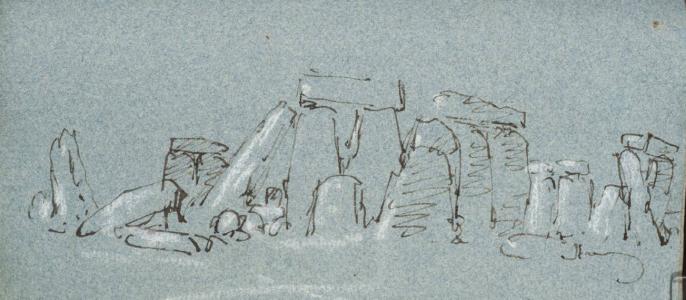 1799. Joseph Mallord William Turner (age 23). Notebook sketch of Stonehenge
1799. Joseph Mallord William Turner (age 23). Notebook sketch of Stonehenge
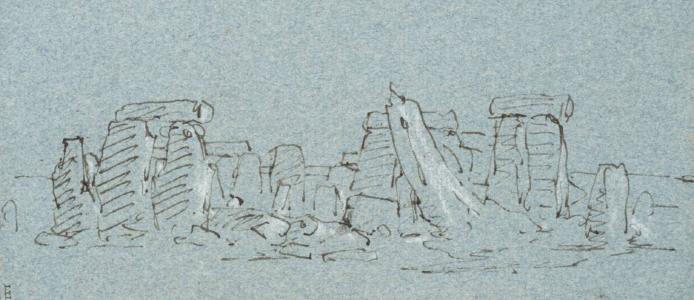 1799. Joseph Mallord William Turner (age 23). Notebook sketch of Stonehenge
1799. Joseph Mallord William Turner (age 23). Notebook sketch of Stonehenge
Archaeologia Volume 13 Section IX. Account of the Fall of some of the Stones of Stonehenge, in a Letter from William George Maton, M.B. F.A.S. to Aylmer Bourke Lambert, Esq. F.R.S. and F.A.S. Read June 29, 1797.
Colt Hoare 1812. Stonehenge.
This remarkable monument is situated on the open down, near the extremity of a triangle formed by two roads; the one leading on the south from Amesbury to Wily, the other on the north from the same place, through Shrewton and Heytesbury to Warminster.1
A building of such an obscure origin, and of so singular a construction, has naturally attracted the attention of the learned, and numerous have been the publications respecting it; conjectures have been equally various, and each author has formed his own. Before I venture to give any opinion on this mysterious subject, it will be necessary for me to lay before my readers those of preceding writers concerning it.
Note 1. Its precise situation will be more satisfactorily explained by the annexed engraving.
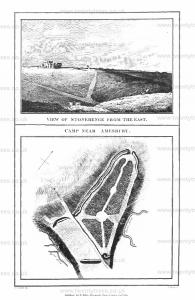
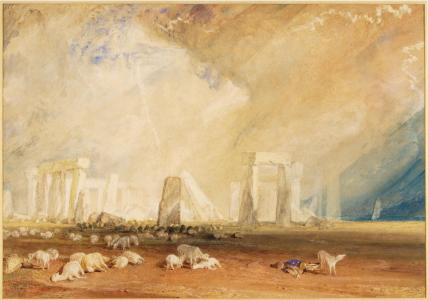 1828. Joseph Mallord William Turner (age 52). Stonehenge
1828. Joseph Mallord William Turner (age 52). Stonehenge
 Around 1833. Richard Tongue (age 38). Sheep Grazing at Stonehenge.
Around 1833. Richard Tongue (age 38). Sheep Grazing at Stonehenge.
 Around 1833. Richard Tongue (age 38). Stonehenge from the South-West.
Around 1833. Richard Tongue (age 38). Stonehenge from the South-West.
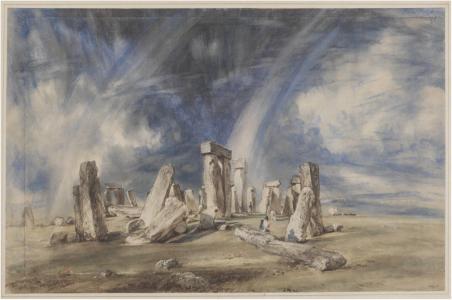 1835. John Constable (age 58). Stonehenge. When he exhibited it in 1836, Constable appended a text to the title: "The mysterious monument of Stonehenge, standing remote on a bare and boundless heath, as much unconnected with the events of past ages as it is with the uses of the present, carries you back beyond all historical records into the obscurity of a totally unknown period."
1835. John Constable (age 58). Stonehenge. When he exhibited it in 1836, Constable appended a text to the title: "The mysterious monument of Stonehenge, standing remote on a bare and boundless heath, as much unconnected with the events of past ages as it is with the uses of the present, carries you back beyond all historical records into the obscurity of a totally unknown period."
Druidical Temples in the County of Wilts Chapter XII. Chapter XII. Stonehenge.
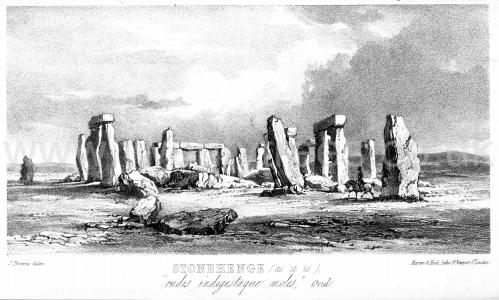
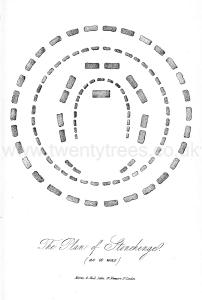
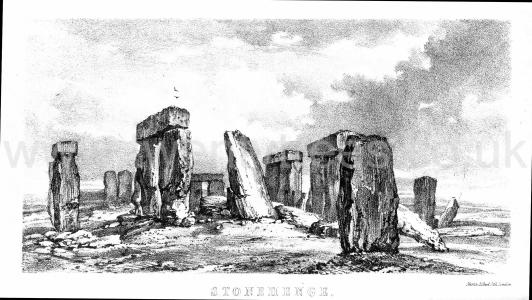
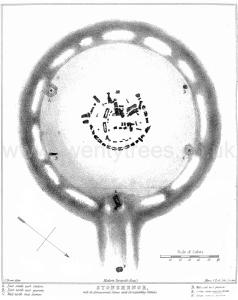
Stonehenge Edward Duke. Letter Relative to Stonehenge by the Reverend Edward Duke (age 71). 1851.
To The Secretary Of The Archaeolological Institute.
My dear Sir,
From the time that I heard of the archæological meeting in this neighbourhood, it had been my wish and hope to have offered to its members a paper on Stonehenge, to which I have given my attention for some years. As the time draws near, however, I find myself compelled, although reluctantly, to decline the more elaborate essay I had purposed. My health, broken by repeated and very severe attacks of illness, will not allow the application of mind to a subject for any length of time without injury.
If, however, you will permit me to do so, I shall venture to offer to your consideration, and submit to your judgment, some points which would have found a place in the contemplated essay, had I been able to complete it.
I think you may be aware that, about three years since, I put through the press a small volume bearing the title of the Druidical Temples of Wilts. In that work Stonehenge was considered as forming part of a planetarium, in connexion with Abury, in the more northern part of the county, and with a series of remains to be traced on the face of the intervening country, the gigantic proportions of which were such that its meridional line was extended no less than two-and-thirty miles. It was while my mind was engaged on this subject, subsequently however to the publication of the book, that the theory of the construction of Stonehenge was gradually presented to it, both with a more distinct outline and in fuller detail. I have not, indeed, found occasion to reject or displace any of the opinions I have formerly expressed: my later occupation has been to add to, and complete my view on this portion of my former subject.
I now, therefore, separate Stonehenge from Abury and the other sacred stations with which, for certain purposes, it was conjoined, and proceed to regard it (as, of course, it may be regarded) in the light of a temple standing alone, entire and perfect in itself, totus in se, teres, atque rotundus.
In approaching Stonehenge, it may be advisable for a stranger, who is making his inspection for the first time, to forbear entering the sacred precincts from that side by which he would naturally arrive on his road from Salisbury ; and to diverge from the path, till he come to the Gnomon, or index-stone, on the north-east side. He will walk from thence beneath the centre arch of the three imposts in front, and so proceed up the temple. In this way, with ordinary attention and intelligence, its plan will become evident at once, which otherwise must appear to the observer involved in a chaotic confusion.
We will suppose our Archaeologist arrived, for the first time in his life, at the outer circle of this venerable monument.
This consisted originally of thirty upright stones, joined together at the top by a continued corona of the same number of imposts: their substance being a silicious grit, permeated here and there with a thin vein of quartz ; and therefore bearing intrinsic evidence that they are Nature's handiwork, and not, as some have supposed — the great Camden among them — from the manufactories of man.
Their height is sixteen feet; their sides shaped into regular parallelograms by the chisel, and their inner surfaces bevelled, from the bottom upwards, for the greater firmness and security of the mass ; a hint which our Norman forefathers did not neglect to observe and follow in the churches which their piety reared in the neighbouring bournes.
These stones, when first set up, were evidently located with great art; externally they must have presented a gentle curve, and internally have shewn a polygon of thirty sides. We have here, then, thirty stones with their thirty intervals, each distinct by itself, and yet all linked together, and united into one, by the one superincumbent and encircling corona. In this, therefore, we behold, in their several and joint characters, the thirty days and thirty nights into which, anciently, each of the twelve months of the year was equally divided, — the perpetual, standing calendar of the Druids for that space of time; or, when multiplied by twelve, their almanac for the year.
A simple arrangement truly, and befitting a simple and unsophisticated people, but not to be denied a higher praise also; for it has been held truly that works of genius are to be known by the most perfect adaptation to their end, combined with the greatest possible simplicity. Of the arrangement of their ecclesiastical year we have, it is true, but little knowledge. Fasts, we may presume, were to them unknown. Of festival days, days of high rejoicing and holy observation, we may not doubt that they had their proper allowance. They were those probably pointed out by nature, or received from earliest primeval tradition — the equinoxes, the solstices, the new moons, and the sabbath-days. Thus, in each monthly revolution, the progress of the month upon any given day would be marked by the stone at which they might then have arrived ; and by this calendar, — for the integrity of which its publicity and the consciences of the priesthood were the vouchers, — the possibility of a national doubt, or of conflicting calculations in any two different parts of the nation, as to precise timet whether in regard to the celebration of sacred feasts or to the fulfilment of civil contracts was averted ; for a reference was always feasible to the great national calendar at Stonehenge, whose fiat would be at once decisive of the doubt or controversy. It was, in fact, the authority of that day, from whose voice there was no appeal.
Proceeding inwards, from the circumference to the centre of the temple, we shall come next to the remains of a circle of smaller stones, of granite, porphyry, &c., concentric with the outer circle. On the number of the stones composing this interior circle much diversity of opinion exists among antiquaries. Upon this question I shall not now enter, but assume that the opinion in which Stukeley and Sir R. C. Hoare concur is the correct one, namely, that it consisted of neither more nor less than forty. I shall take leave, however, to disagree with Sir Richard, and also Mr. Cunnington, as to their decision upon another point. They have advanced an opinion that the larger stones at Stonehenge were erected, in point of time, previously to the smaller ones, which last they think to have been subsequently inserted among them.
Around 1885. Farm waggons near Stonehenge.
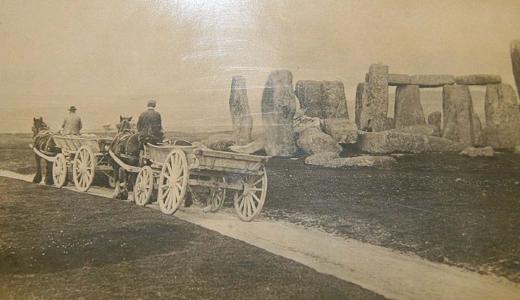
In 1901 Edmund Antrobus 4th Baronet (age 52) commissioned the the first major restoration of Stonehenge which he owned.
Sep 1901. Professor William Gowland’s excavation at Stonehenge.
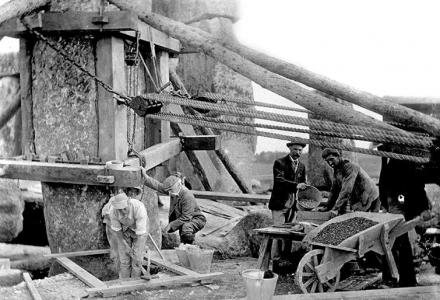
 . 1904. Albert Durer Lucas (age 76). Stonehenge on Salisbury Plain.
. 1904. Albert Durer Lucas (age 76). Stonehenge on Salisbury Plain.
In 1905 Edmund Antrobus 4th Baronet (age 56) was initiated into the Ancient Order of Druids and, thereafter, allowed ceremonies to take place at Stonehenge.
Stonehenge was visited last week by a numerous part of Druids, who performed with great solemnity a series of strange and mystic ceremonies around the old monuments. The Ancient Order had travelled to Stonehenge to hold a lodge there. They began operations with a luncheon, at which Sir Edmund Antrobus (age 56), the proprietor of the land on which Stonehenge stands, was the guest. Then Sir Edmund and many others were initiated into the mysteries and nature of the Order. Behind an altar stood the Most Nobel Grand Arch, and on either side of him extended a line of bards [?], wondrously arrayed and bearded, and carrying staffs and symbols. Then the candidates for the initiates were led in blindfolded, such candidates with hand on the shoulder of the man in front. There was, it is sais, some laughter from the crowd as they filed forth, but the hymn of welcome drowned the ribaldry, and they were brought to their place between the lines of bearded bards in a burst of melody. The initiation was solemn and severe, and, as a spectacle, was a great success. Our photographs are by Reinhold, Thiele and Co.
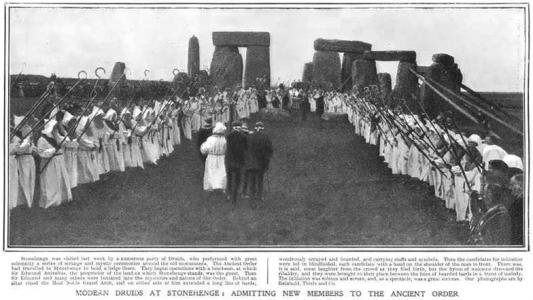
After 1914. Post-First World War aerial photograph of Stonehenge.
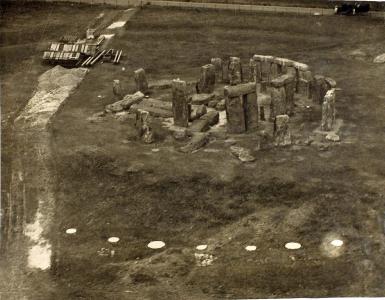
On 11 Feb 1915 Edmund Antrobus 4th Baronet (age 66) died. His brother Cosmo Gordon Antrobus 5th Baronet (age 56) succeeded 5th Baronet Antrobus of Antrobus in Cheshire, and inherited the Amesbury Abbey, Wiltshire [Map] estate including Stonehenge.
The Times. 13 Feb 1915. Death of Sir Edward Antrobus (deceased)
Owner and Guardian of Stonehenge.
Colonel Sir Edward Antrobus (deceased), Bt., died at Amesbury Abbey [Map], on Thursday afternoon at the age of 67. He is succeeded by his only remaining brother, Mr. Cosmo Gordon Antrobus (age 56). His only son [Edmund Antrobus], who was a Lieutenant in the Grenadier Guards, was killed in action on October 24 last.
Sir Edmund Antrobus will be remembered as the owner of the famous Stonehenge, on Salisbury Plain, which was included in the Amesbury Abbey estate of about 8000 acres. After consulting with the Society of Antiquaries, the Society of Ancient Monuments, and the Wilts Archaeological Society, Sir Edmund determined to enclose the monument by wire fencing, and the action led to litigation in the High Court. In April, 1905, the Solicitor-General claimed an order against the owner to remove the fencing, and an injunction to restrain him from erecting such fencing. The claim was based on two grounds - (1) That Stonehenge was a national monument of great interest, and was subject to trust for its freer use by the public: and (2) that there were public roads running up to and through Stonehenge, and that those roads had been blocked by the defendant's fencing. Sir Edmund produced title deeds showing the purchase in fee by this great-great-uncle from the trustees of the Duke of Queensbury, some seventy years before, and an absolute fee simple title in himself. Mr. Justice Farwell, in giving judgement for Sir Edmund, observed that it was only fair to the defendant to say that he was not acting capriciously, but on expert advice, the preservation of the stones.
On 21 Sep 1915 Cosmo Gordon Antrobus 5th Baronet (age 56) sold Stonehenge at auction. It was bought by Cecil Herbert Edward Chubb 1st Baronet (age 39); see Archaeologia Cambrensis Series 6 Volume 15 1905 Stonehenge.
Archaeologia Cambrensis Series 6 Volume 15 1905 Stonehenge. 22 Sep 1915. Sale of Stonehenge. — Great public interest was shown in the sale by auction at Salisbury yesterday [September 21st] of the Amesbury Abbey estate, including Stonehenge. Sir Howard Frank, of Messrs. Knight, Frank and Rutley, conducted the sale, and explained that the estate came into the market in consequence of the deaths of Sir Edmund Antrobus and of his only son, who was killed in action last October. The estate, which has many historical associations, comprises 6,420 acres, and has an estimated rental of £5,359. It was first submitted as a whole, but as no purchaser was forthcoming it was offered in lots, of which Amesbury Abbey and grounds formed the first. This was unsold. Farms and buildings in the town of Amesbury, however, sold at good prices, and most of the property changed hands. When Stonehenge was put up for sale Sir Howard Frank asked for an opening bid of £5,000. A bid for that amount was made at once, quickly followed by an advance of £100, and £6,000 was readied within a minute. Then there was a lull. The auctioneer said the price was a poor one for Stonehenge, which could not be valued, but if there were no further offers he would accept it. Bidding recommenced and mounted to £6,600, at which the property fell to a local landowner, Mr. C. H. E. Chubb (age 39), of Bemerton Lodge, Salisbury. After the sale Mr. Chubb said that when he went into the sale room he had no intention whatever of buying the monument. "While I was there," he added, I thought a Salisbury man ought to buy it, and that is how it was done." Asked if he had any plans for the future of Stonehenge, Mr. Chubb said that, while he intended to preserve the monument, he would do nothing for some little time, as he had to consider the position. — Times, September 22nd, 1915.
Profits Of Stonehenge. — -Mr. Chubb, the new owner of Stonehenge, will not be given legal possession for some months. Meanwhile he has formulated no plan for the future, except that he is determined to take every step to see that the stones are preserved as heretofore.
The opinion expressed locally is that Mr. Chubb has made an excellent bargain, quite apart from the historic interest attaching to Stonehenge. As the purchase price was £ 6,600, and the net receipts from fees paid by visitors to the enclosure average £ 360 per annum, the transaction, regarded in a cold commercial light, represents an investment of over 5 per cent.Times, September 23rd, 1915.
Stonehenge: Its Recent Sale And Price.- The following letter appeared in "The Times of October 6th, 1915:— Sir, — The sale by auction a few days ago of Stonehenge for the comparatively small sum of £ 6600 will, I think, cause regret in many quarters that the opportunity was lost of vesting this most important national monument in some public body, and of restoring to the public the access to it, free of charge, which had been enjoyed for countless centuries. It will be recollected that fourteen years ago litigation was undertaken with this object. The claim was made that two well-worn ways leading up to, and through, the outer circle of stones were obstructed by the inclosure, which was erected partly with the object of guarding the stones, but mainly for the purpose of enforcing a charge of admission of Is. a head. Those of us who were engaged in this attempt were worsted in the suit and were heavily mulcted in costs. It was not generally known, however, and could not be stated at the hearing of the suit, that at an early stage of the proceedings we offered to purchase the monument and a few acres of Down land surrounding it for the sum of £ 10,000, with the purpose of placing the monument under the full protection of the Ancient Monuments Act. The effect of this would be that the Government would be charged with the duty and cost of guarding and preserving the stones, and that access of the public to them would be secured, free of charge, for ever. 1 he then owner of the property did not object to a sale, but he said that his price was £ 50,000. For this sum he had already offered the monument to the Government, and when it was rejected, on the ground that it was altogether exorbitant, he threatened to sell the stones to an American millionaire, who would ship them across the Atlantic. The then Chancellor of the Exchequer, to whom the offer and threat were verbally made, very properly replied that if an attempt was made to remove the monument he would send a regiment from the camp on Salisbury Plain to prevent it. In spite of this rebuff, the excessive price was insisted upon, with the result that the suit was proceeded with. Since then the admission fees have been maintained, and I am informed that the visitors to Stonehenge have been only one-fourth in number of what they used to be. The net produce from the charge for admission has averaged the last three years L320, after deducting the cost of guarding and preserving it. The fees for admission during the last half-year have been greatly reduced in consequence of the war.
"When, a few weeks ago, the intended sale of the monument was announced, I would gladly have made an effort to raise a sum for its purchase, with the object of undoing the wrong which had been done in 1901. But I found that, in view of the many claims arising out of the war, it was impossible to raise by subscription even the moderate sum which appeared to be the full commercial value of the monument, based on the admission fees.
"There remained, however, the possibility that the monument might be purchased by some public body, such as the National Trust, who would maintain the charge for admission to it until more favourable times, when it would be possible to reduce or abolish that charge. In this view, the National Trust, at my suggestion, entered into a correspondence with Messrs. Knight, Frank and Rutley, the agents for the sale of the Amesbury estate. The society had no funds at its immediate disposal for such a purpose, but among its generous supporters there would probably have been found those who would advance the purchase-money on loan on the security of the admission fees. It was necessary, however, before applying to any such friends, to know the price demanded for the monument. The society was informed by the agents that the owner could not name a price, but was prepared to entertain any offer from the National Trust above the sum of £ 10,000 — a price evidently based upon the offer made for it fourteen years ago. The society replied to this that, after careful consideration, they had come to the conclusion that the minimum price named by the owner was altogether excessive, particularly in view of the exceptional conditions consequent on the war, and that they were unable to make an offer of that amount or above it.
"The reply of the agents to this, on September 17th, was 'that the vendor, who is a tenant for life of the property, would not be justified in selling Stonehenge previous to the auction except at a price which was considered by us (Messrs. Knight, Frank and Rutley) to be high.' They added — 'The reserve at the auction, however, is a low one, in our view, and is thousands of pounds below the amount mentioned in our previous letter,' namely, £10,000. They suggested that the National Trust should be represented at the auction. It was thus practically admitted that the price named by the owner in the previous letter was, in the opinion of the experienced agents who advised him, too high by some thousands. The letter was received by the National Trust on Saturday, September 18th, three days before the sale by auction. It was impossible, in this short interval, to make arrangements for finding the possible purchase-money. The society, therefore, was not represented at the auction, and made no bid. The monument was bought for S6600 by a gentleman resident in the neighbourhood, who has stated that he has bought it as an investment, but with the full intention of doing his best to preserve it a promise which I doubt not he will fulfil. Not the less, however, it is to be regretted that the monument has not become the property of some public body, with the prospect of the reduction or remission of the entrance fees. I may be permitted also to point out that the price obtained at the auction, while it confirms the opinion of the agents who conducted the sale, is also striking proof that the sum offered for the monument in 1901 was most generous, and such as, in the interest of the entailed estate and of the public, should have been accepted.
I am yours faithfully,
Eversley.
"Abbotsworthy House, Winchester,
"October 1st."
In 1918 Cecil Chubb (age 41) wrote a letter to Sir Alfred Mond, the holder of the office of "First Commissioner of Works" in Government and the man in charge of all things to do with Ancient Monuments under the 1913 Act:
Bemerton Lodge, Salisbury, 15th September 1918
Dear Sir,
Stonehenge is perhaps our best known and the most interesting of our national monuments, and has always appealed strongly to the British imagination. To me, who was born close to it and during my boyhood and youth visited it at all hours of the day and night, under every conceivable condition of weather – in driving tempests of hail, rain and snow, fierce thunderstorms, glorious moonlight, and beautiful sunshine, it always has had an inexpressible charm.
I became the owner of it with a deep sense of pleasure, and had contemplated that it might remain a cherished possession of my family for years to come. It has, however, been pressed upon me that the nation would like to have it for its own and would prize it most highly. I, therefore, have decided to give up this unique possession and offer it to you, his Majesty’s First Commissioner of Works, as a gift to be held for the nation.
It brings in a revenue, and its possession would be far from an expense. If my wife and I may express a wish, though far from making it a condition of the gift, we should be glad if during the continuance of the war the income could be handed to the Red Cross Society, whose work at the present time is of such great national value. This point, however, must be entirely within your discretion.
I have the honour to be
Yours faithfully
C.H.E Chubb (age 41)
On 26 Oct 1918 Cecil Herbert Edward Chubb 1st Baronet (age 42) gave Stonehenge to the nation with the following conditions:
First that the public shall have free access to the premises hereby conveyed and every part thereof on the payment of such reasonable sum per head not exceeding one shilling for each visit and subject to such conditions as the Commissioners of Works in the exercise and execution of their statutory powers and duties may from time to time impose Secondly that the premises shall so far as possible be maintained in their present condition Thirdly that no building or erection other than a pay box similar to the Pay Box now standing on the premises shall be erected on any part of the premises within four hundred yards of The Milestone marked "Amesbury 2" on the northern frontage of the premises and Fourthly that the Commissioners of Works will at all times save harmless and keep indemnified the Donors and each of them their and each of their estates and effects from and against all proceedings costs claims and expenses on account of any breach or non-observance of the covenants by the Donors to the like or similar effect contained in the Conveyance of the premises to the Donors.
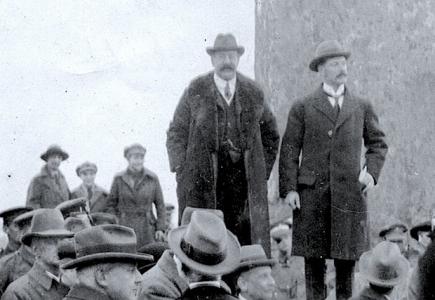
Around 1919. Repairs at Stonehenge.
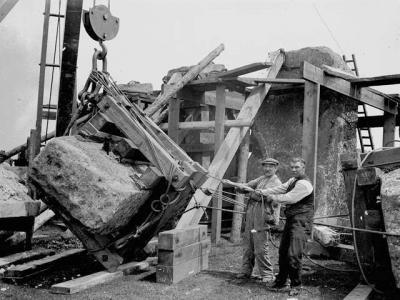
On 12 Apr 1921 a resolution was passed by Amesbury Parish Council: "...the Council relinquishes all claims on the right of way now enclosed, on condition that all householders and their families, (or all inhabitants) of the parishes, comprising the Rural District of Amesbury, and the householders and their families (or inhabitants) of the Parish of Netheravon, be granted free admission to Stonehenge at all times. Subject to the usual rules and regulations made by the Board for the proper management of Stonehenge as an Ancient Monument."
Jul 1928. Aerial view of Stonehenge shows Hawley’s excavation huts to the south-east (left) of Stonehenge and the remaining aerodrome buildings in the distance. © Historic England Archive
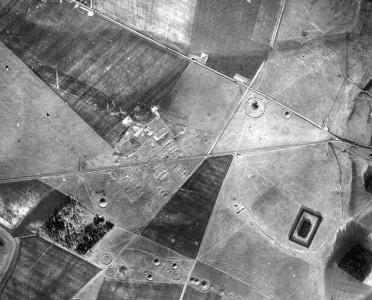
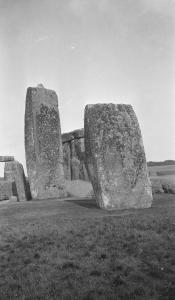 1933. Paul Nash (age 43). Black and white negative, Stonehenge, study I.
1933. Paul Nash (age 43). Black and white negative, Stonehenge, study I.
 1933. Paul Nash (age 43). Black and white negative, Stonehenge, study I.
1933. Paul Nash (age 43). Black and white negative, Stonehenge, study I.
24 Dec 1943. Aerial view of Stonehenge, taken from a US Air Force plane on Christmas Eve 1943. © Historic England Archive
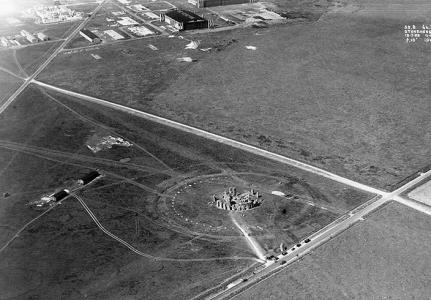
Around 1950. A major project was underway to restore some fallen stones at Stonehenge. This included an entire trilithon that had fallen in 1797. Even with the technology of the day, it proved to be a huge challenge and one of the largest cranes in the country had to be brought in for the job. The specialist crane, known as a Curran crane, was built for lifting an aircraft up to 60 tons and there happened to be one nearby at Boscombe Down. The heaviest of the stones combined with its cradle weighed around 60 tons, so it was right on the edge of its maximum capability. Crane operator David Healy remembers when he got the call to help with the restoration work at Stonehenge: "At RAF Boscombe Down we were preparing numerous aircraft for the Cold War … I was asked to help the crane operators at Stonehenge … I knew about cranes from the aircraft … We got into the main circle … one of the main sarsen stones had fallen down … we got it up into position and the other workers packed stones round the bottom … we got one of the lintel stones up and put up a blue stone on the way".
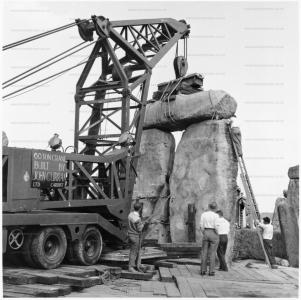
1958. Restoration of Stonehenge. Photos sourced from Rare Historical Photos.
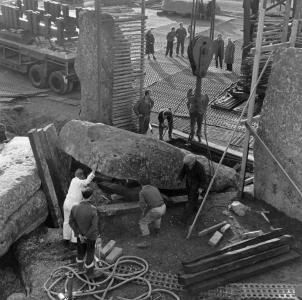
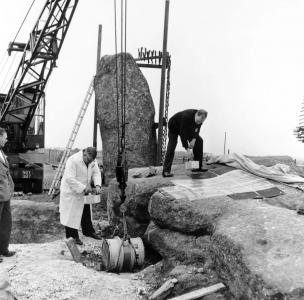
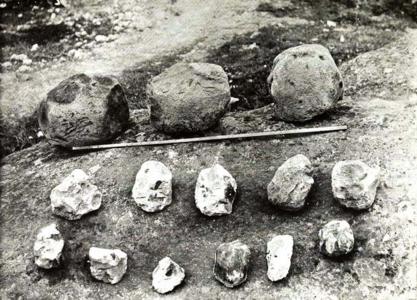 Sarsen mauls and flint hammerstones excavated during the restoration.
Sarsen mauls and flint hammerstones excavated during the restoration.
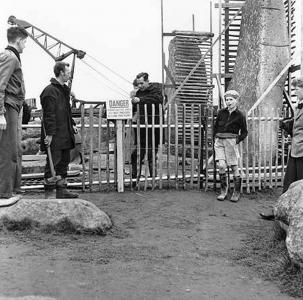
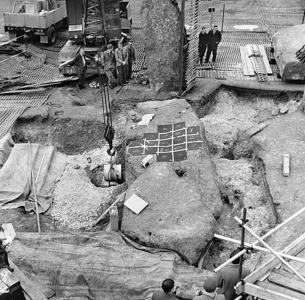
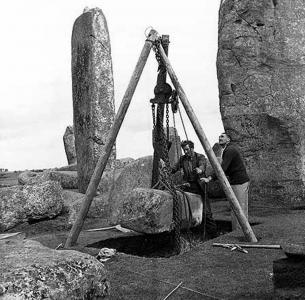 Lifting Bluestone 36 with block and tackle.
Lifting Bluestone 36 with block and tackle.
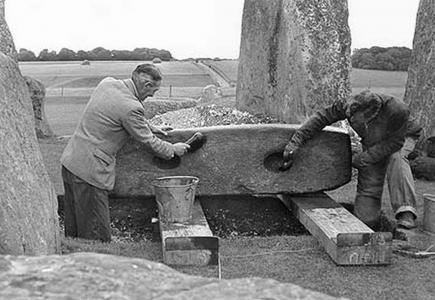 Bluestone lintel 36 being cleaned after excavation. The presence of finely tooled mortices indicates that it was re-used from an earlier bluestone Trilithon. 1954. (Photo credit: Historic England Archive).
Bluestone lintel 36 being cleaned after excavation. The presence of finely tooled mortices indicates that it was re-used from an earlier bluestone Trilithon. 1954. (Photo credit: Historic England Archive).
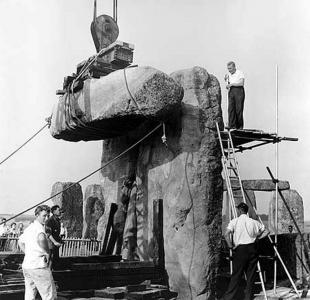 Lintel 158 is hoisted into position on top of the restored west trilithon.
Lintel 158 is hoisted into position on top of the restored west trilithon.
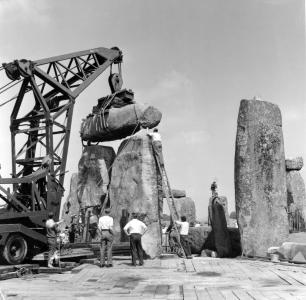 Lintel 158 is hoisted onto its perch atop the restored west trilithon. The borrowed RAF ‘Babarazon aircraft crane could lift up to 60 tons — approaching its limits with the huge stone uprights.
Lintel 158 is hoisted onto its perch atop the restored west trilithon. The borrowed RAF ‘Babarazon aircraft crane could lift up to 60 tons — approaching its limits with the huge stone uprights.
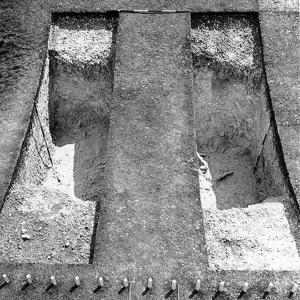 Cuttings C41 and C42 across Segment 98 of the henge ditch. Two antlers found at the bottom of C42 (seen in this image) gave calibrated radiocarbon dates of 3340-2910 cal BC. (Photo credit: Historic England Archive).
Cuttings C41 and C42 across Segment 98 of the henge ditch. Two antlers found at the bottom of C42 (seen in this image) gave calibrated radiocarbon dates of 3340-2910 cal BC. (Photo credit: Historic England Archive).
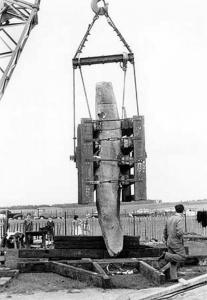 Stone 23 of the outer sarsen circle, which collapsed in December 1900, being lifted prior to its re-erection. (Photo credit: Historic England Archive).
Stone 23 of the outer sarsen circle, which collapsed in December 1900, being lifted prior to its re-erection. (Photo credit: Historic England Archive).
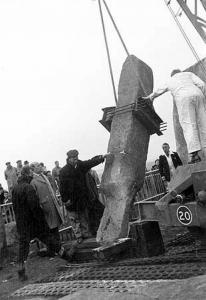 Bluestone 69 of the Bluestone Horseshoe being removed to allow a crane access to lift fallen Trilithon stones 57 and 58. This stone was replaced after the re-erection of the Trilithon. 1958. (Photo credit: Historic England Archive).
Bluestone 69 of the Bluestone Horseshoe being removed to allow a crane access to lift fallen Trilithon stones 57 and 58. This stone was replaced after the re-erection of the Trilithon. 1958. (Photo credit: Historic England Archive).
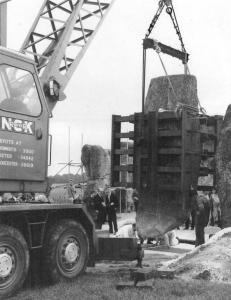 Moving stone 22.
Moving stone 22.
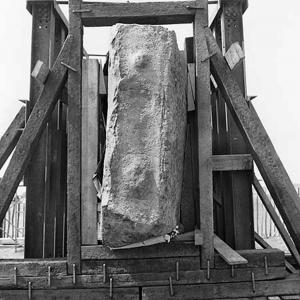 The top of sarsen stone 23, showing two tenons to secure lintels. The stone collapsed in 1964 and was re-erected by Professor Atkinson in 1964. Encased here in a protective cradle, ready for re-erection.
The top of sarsen stone 23, showing two tenons to secure lintels. The stone collapsed in 1964 and was re-erected by Professor Atkinson in 1964. Encased here in a protective cradle, ready for re-erection.